Blog & Latest Updates
Fly Fishing Articles
Insects by Common Name


Mayfly Species Rhithrogena morrisoni (Western March Brown)
Taxonomic Navigation -?-
Kingdom
Animalia (Animals)
» Phylum
Arthropoda (Arthropods)
» Class
Insecta (Insects)
» Order
Ephemeroptera (Mayflies)
» Genus
Rhithrogena
» Species morrisoni (Western March Brown)
Common Names
| Match | Common Name |
| Western March Brown | |
| Western Black Quill | |
| Black Quill |
These large flies range between 9mm and 12mm and are the first important hatch of the year. Generally speaking, they have two distinct color phases and hatching periods, with the Coastal states having the lighter version emerging late February through April in lower elevation tailwaters and the darker version in the Rocky mountain states emerging a month or two later. This has led to much confusion as these significant regional differences are seldom pointed out in angling literature.
They offer the western angler some of the finest fishing of the year during moderate precipitation cycles. It's biggest spoiler is high water or early runoff. On many rivers, there is also a fine hatch of a large late Winter stonefly (Skwala spc.) that usually precedes it that helps to get the fish "looking up". It is the West's equivalent of the East's mottle winged Macaffertium vicarium (American March Brown), both in terms of appearance and importance. Primarily due to western fishing seasons of the past that excluded this mayfly's activity, reporting on this species in angling literature is a relatively recent phenomenon. Thus, it lags in tradition compared to the blotchy winged Heptageniidae of the East and Midwest. But given time...
Where & When
Region: West
Time Of Year (?): Late February to mid-June
Preferred Waters: All types of fast water but best in cobble runs of medium depth fast to moderate flow
Hatching Behavior
The duns leave their nymphal shucks (
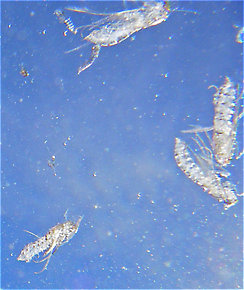
Here's an underwater view of the pupal shucks of several already-emerged Brachycentrus numerosus caddisflies.
Spinner Behavior
Time Of Day: Same as emergence
Spinner falls may sometimes be important.Nymph Biology
Current Speed: All current speeds
Substrate: Gravel
This species is more tolerant of slow water than most in Rhithrogena, but it also does well in the very fast water typical of the genus.Substrate: Gravel
Pictures of 4 Mayfly Specimens in the Species Rhithrogena morrisoni:
Male Rhithrogena morrisoni (Western March Brown) Mayfly Spinner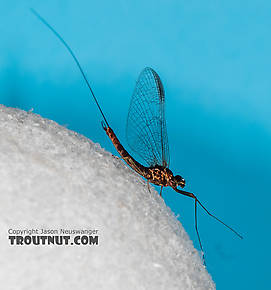 View 9 Pictures
View 9 Pictures
 View 9 Pictures
View 9 PicturesCollected June 22, 2017 from the South Fork Snoqualmie River in Washington
Added to Troutnut.com by Troutnut on June 23, 2017
Added to Troutnut.com by Troutnut on June 23, 2017
Rhithrogena morrisoni (Western March Brown) Mayfly Nymph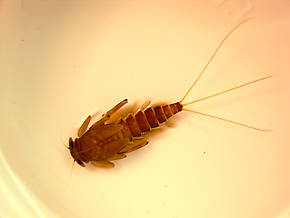 View 4 PicturesSize - (excluding tails) - 12 mm
View 4 PicturesSize - (excluding tails) - 12 mm
Status at time of photo - preserved, but photographed within days of capture.
W. C. Day, Aquatic Insects of California differentiates morrisoni nymphs by submedian pale dots on tergites (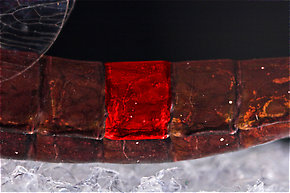 Tergite: The top (dorsal) part of a single segment on an insect's abdomen when it consists of a single chitinous plate (sclerite), or an individual sclerite if the segment has more than one.) 8 & 9, which look to be in evidence. This is one of the "super-hatches" on this river that can be prolific March through April.
Tergite: The top (dorsal) part of a single segment on an insect's abdomen when it consists of a single chitinous plate (sclerite), or an individual sclerite if the segment has more than one.) 8 & 9, which look to be in evidence. This is one of the "super-hatches" on this river that can be prolific March through April.
Entoman
 View 4 PicturesSize - (excluding tails) - 12 mm
View 4 PicturesSize - (excluding tails) - 12 mmStatus at time of photo - preserved, but photographed within days of capture.
W. C. Day, Aquatic Insects of California differentiates morrisoni nymphs by submedian pale dots on tergites (

One tergite of this Isonychia bicolor mayfly spinner is highlighted in red.
Entoman
Collected March 3, 2011 from the Lower Yuba River in California
Added to Troutnut.com by Entoman on November 1, 2011
Added to Troutnut.com by Entoman on November 1, 2011
Male Rhithrogena morrisoni (Western March Brown) Mayfly Spinner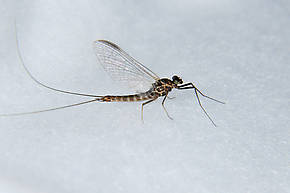 View 2 Pictures
View 2 Pictures
 View 2 Pictures
View 2 PicturesCollected April 20, 2012 from the Touchet River in Washington
Added to Troutnut.com by Bnewell on April 21, 2012
Added to Troutnut.com by Bnewell on April 21, 2012
Your Thoughts On Rhithrogena morrisoni:
Top 10 Fly Hatches
Top Gift Shop Designs
Eat mayflies.
Top Insect Specimens
Miscellaneous Sites
Troutnut.com is copyright © 2004-2024 Jason
Neuswanger (email Jason). See my FAQ for information about use of my images.
 privacy policy
privacy policy
